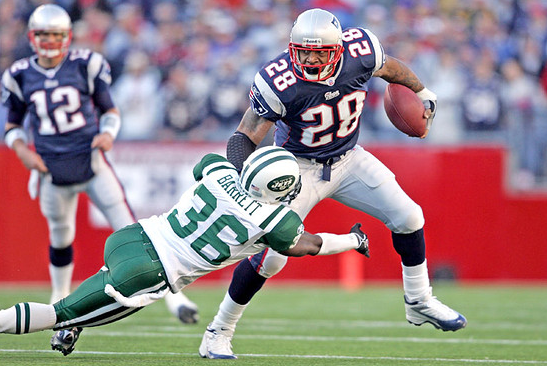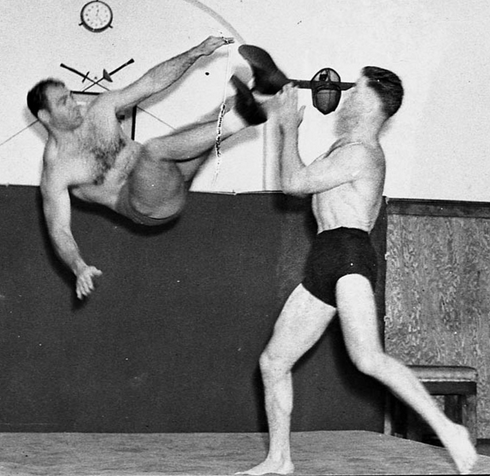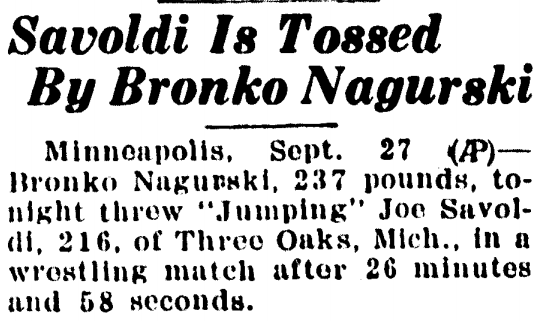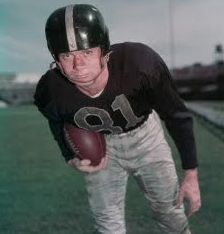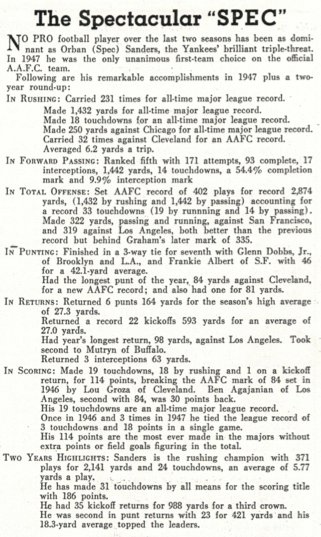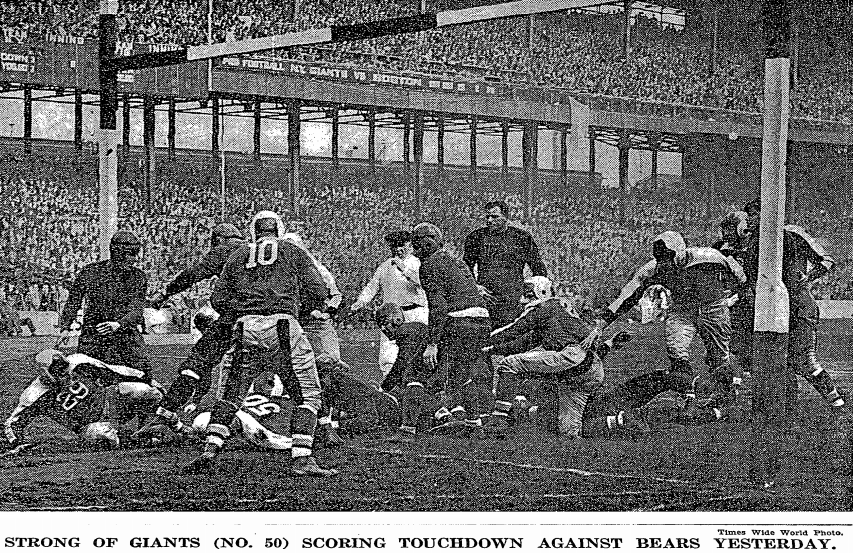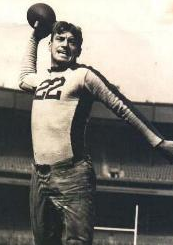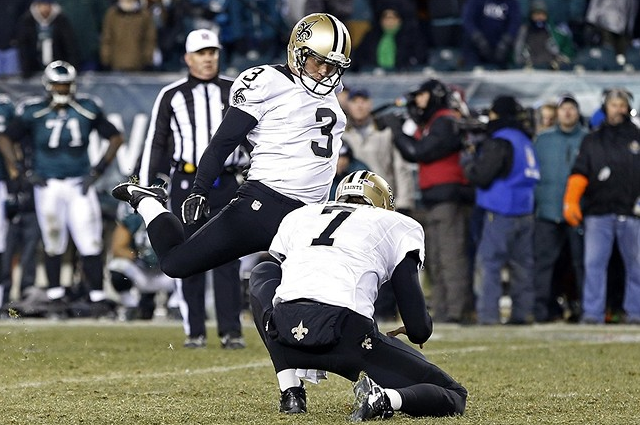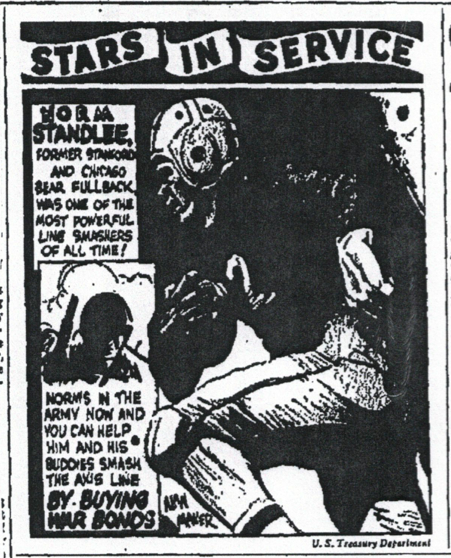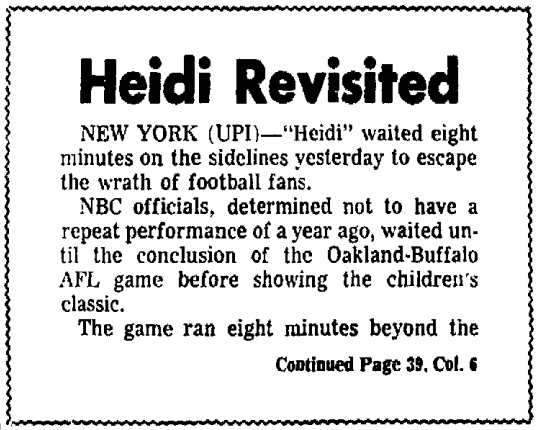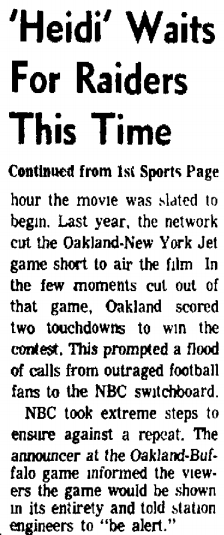Enjoy the archives.
A forgotten QB’s finest hour
You won’t find Steve Pelluer’s name on any All-Time Greatest Quarterback lists. He was 9-20-1 as a starter with the Cowboys and Chiefs in the late ’80s and had a career passer rating of 71.6. When Tom Landry’s Hall of Fame career came to an ignominious end in 1988, Pelluer was his QB.
Steve did have a few nice moments, though. In fact, on this day in 1986, he played — for my money, at least – one of the most amazing games by a quarterback the NFL has seen. He didn’t do this 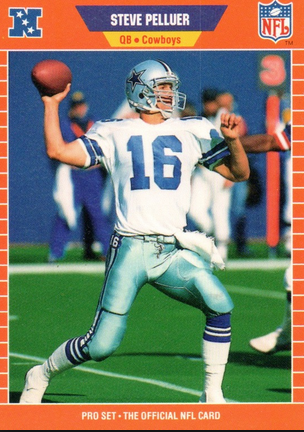 by throwing for a bunch of yards or touchdowns, either; he did it by surviving. Even though the Chargers sacked him 11 times (one off the record) for 93 yards, he didn’t throw a single interception, completing 18 of 33 passes for 246 yards and a touchdown.
by throwing for a bunch of yards or touchdowns, either; he did it by surviving. Even though the Chargers sacked him 11 times (one off the record) for 93 yards, he didn’t throw a single interception, completing 18 of 33 passes for 246 yards and a touchdown.
But here’s the best part: In the late going, he took Dallas down the field, 61 yards in four plays, for the deciding score in a 24-21 victory — and did the honors himself by running two yards around right end. I ask you: How many QBs in pro football history have been more resolute than Pelluer was that afternoon in San Diego?
Twice, he was sacked on back-to-back plays. Another time, he was flushed from the pocket — such as it was — and managed to pick up a couple of yards (thus avoiding sack No. 12). Another time, Chargers defensive end Earl Wilson roughed him for a 15-yard penalty. But Pelluer never flinched, despite spending much of the game with rookie Leslie O’Neal (five sacks for 43 yards), the future Pro Bowl pass rusher, on top of him. His 11 sackings:
1. First quarter, 2nd and 7, Dallas 25 — Loss of 10 (sacked by O’Neal).
2. Second quarter, 1st and 10, Dallas 27 — Loss of 8 (NT Chuck Ehin).
3. Second quarter, 3rd and 6, Dallas 11 — Loss of 8 (O’Neal). Fumble (Pelluer recovered).
4. Second quarter, 2nd and 16, Dallas 38 — Loss of 12 (O’Neal). Fumble (OT Mark Tuinei recovered).
5. Second quarter, 1st and 10, Dallas 39 — Loss of 11 (DE Lee Williams).
6. Third quarter, 2nd and 4, San Diego 35 — Loss of 7 (Ehin).
7. Third quarter, 3rd and 11, Dallas 42 — Loss of 7 (DE Dee Hardison).
8. Third quarter, 1st and 10, Dallas 45 — Loss of 6 (Williams and LB Gary Plummer).
9. Fourth quarter, 1st and 10, San Diego 40 — Loss of 5 (O’Neal).
10. Fourth quarter, 3rd and 15, San Diego 45 — Loss of 11 (Williams).
11. Fourth quarter, 2nd and 8, San Diego 42 — Loss of 8 (O’Neal).
After that last sack, which forced a punt, the Cowboys trailed 21-17 with 4:18 left. They got the ball back at the 2:09 mark, and then this happened:
Completion, completion, completion — followed by a quarterback keeper for a TD. How’s that for a finish to an 11-sack game?
Two weeks later, the Eagles’ Randall Cunningham was sacked 12 times in a 33-27 overtime win over the Raiders. He, too, ran for the deciding score. So why aren’t I writing about that performance? Because (a.) Cunningham threw a pick in the last two minutes of regulation to enable the Raiders to send it into OT, and (b.) because it was the Philadelphia defense that ultimately won the game, forcing a fumble that strong safety Andre Waters returned to the Raiders 4. (Why the Eagles punched it in from there instead of kicking a field goal, only Buddy Ryan knows.)
Usually when a team’s quarterback(s) get sacked 11 or more times, the result is pretty predictable. Since 1960, clubs are 2-28 in those situations.
But Steve Pelluer bucked the odds — and for that, Pro Football Daly salutes him.
(Which isn’t to say he was totally unaffected by the San Diego stampede. “On one play,” he said afterward, “I handed off to the wrong guy. That was a play after I got hit. It was that kind of rush.”)
Source: pro-football-reference.com
Running back consistency
Thanks to the Cardinals’ uncooperative defense in Week 9, DeMarco Murray’s quest to be the first NFL back to rush for 100 yards in every game of a season has been quashed. That said, 100 yards — as nice and round a number as it is — is still just a number. Would it surprise you to learn that no back has rushed for even 75 yards in all of his team’s games? I mention this because the Cowboys’ Murray had 79 against Arizona, so the feat is still within reach.
Indeed, only two other backs have gotten as far as DeMarco has — 75-plus rushing yards in each of the first 10 games. They are: Terrell Davis with the 1997 Broncos and Edgerrin James with the 2005 Colts. (Jim Brown, O.J. Simpson and Eric Dickerson didn’t even do it the years they broke the single-season rushing record.)
Sure, 75 yards is as arbitrary as 100, but it might be considered, at the very least, a “quality start.” Gaining that many yards week in and week out shows a fairly high level of consistency, does it not? Here are the backs who’ve come closest to doing it in every game of a season:
MOST GAMES WITH 75 OR MORE RUSHING YARDS, SEASON
| Year | Running back, Team | 75+ | Low Game |
|---|---|---|---|
| 2004 | Corey Dillon, Patriots | 15 | 79 vs. Bills |
| 2011 | Maurice Jones-Drew, Jaguars | 15 | 63 vs. Texans |
| 2012 | Adrian Peterson, Vikings | 15 | 60 vs. Colts |
| 2008 | Adrian Peterson, Vikings | 15 | 32 vs. Saints |
| 2003 | Jamal Lewis, Ravens | 14 | 68 vs. Jaguars |
| 1985 | Marcus Allen, Raiders | 14 | 50 vs. Chiefs |
| 2012 | Alfred Morris, Redskins | 14 | 47 vs. Vikings |
| 2012 | Marshawn Lynch, Seahawks | 14 | 41 vs. Patriots |
| 1984 | Eric Dickerson, Rams | 14 | 38 vs. 49ers |
| 1983 | Eric Dickerson, Rams | 14 | 37 vs. Redskins |
| 2009 | Chris Johnson, Titans | 14 | 34 vs. Colts |
| 1992 | Barry Foster, Steelers | 14 | 25 vs. Bears |
| 1997 | Barry Sanders, Lions | 14 | 20 vs. Bucs |
| 1973 | O.J. Simpson, Bills | 13* | 55 vs. Dolphins |
*14- game season (so only once did he fall below the 75-yard threshold).
If you’re confused by Dillon’s line, let me explain: He missed a game that season. In the other 15, he rushed for 75 or more yards (gaining, on his worst day, 79 against Buffalo in Week 3. So he rushed for 75+ in every one of his games but not in every one of New England’s games.
Regardless, it’s an impressive accomplishment. Consider: The Patriots went 17-1 (postseason included) in the games Dillon played, capped by their Super Bowl win over the Eagles. And in the one they lost — 29-28 to the Dolphins — they blew an 11-point lead in the last three minutes. That’s how close he came to a perfect season. You’d have to think his utter reliability had something to do with it.
Source: pro-football-reference.com
Friday Night Fights X: Joe Savoldi vs. Man Mountain Dean, 1934
The Bears’ signing of “Jumping Joe” Savoldi, the star fullback from Notre Dame, late in the 1930 season was a national story. Savoldi had been booted out of school in mid-November when it was discovered he was married — a no-no for college athletes back then — and George Halas was quick to get him in a Chicago uniform, even if he had to pay a $1,000 fine because Savoldi’s class had yet to graduate. (This, remember, was several years before the NFL had a draft. Teams were free to sign any player they wanted.)
Despite making great money with the Bears, Savoldi played just three games for them — the only games of his pro football career. He then turned to wrestling and, according to
wrestlingdata.com, had over 600 matches in the next 23 years (and briefly held one of the dime-a-dozen heavyweight “titles”). Years later, he explained the sudden switch to Frank Blair of the Long Beach Press-Telegram.
His Bears teammates, he said, weren’t too thrilled when they found out what Halas was paying him, and
they quit blocking for me. . . . Here I was getting some $4,000 a game with my cut of the gate, and my teammates in the line and backfield were being paid $50 to $125 per man. . . . If I was worth 20 times as much as they were, I could make my own touchdowns without any help. After I had been riddled a dozen times trying to hit the line or sweep off tackle, I just fell down and stayed there. I didn’t have a chance.
So they took me out and kept me on the bench after the second game — not because I couldn’t play football, but [because] the other guys wouldn’t play and block for me. I had a contract for 18 games after that first season, with a guarantee of $500 a game, but I didn’t want any part of that pro football. I went into wrestling. In that business you don’t need blockers.
As you might expect of a wrestler with 600 bouts, Savoldi took on anybody and everybody, from legends like Strangler Lewis and Jim Londos to ex-football players like Bronko Nagurski (his former Bears teammate), Gus Sonnenberg, Jim McMillen, Sammy Stein, Mayes McClain and Roy “Father” Lumpkin.
Nagurski was the champion himself for a while. Wrestlingdata.com has him beating Savoldi three out of three, but it seems to have missed this match in 1938:
During World War II, Savoldi performed some kind of “secret mission” for the U.S. government. Jack Cuddy of The Associated Press wrote about it in 1945. Savoldi wasn’t able to provide him with much detail — it was all very hush-hush — but Cuddy had his suspicions. Joe, he noted, had been born in Italy, and not only was fluent in Italian but knew a fair amount of French.
All Savoldi told him was that he was “on special assignment. Yes, I am permitted to tell you what areas I visited. They were North Africa, Sicily, Italy — including Salerno — and France — including Normandy. Yes, I was under fire — plenty of times. No, I wasn’t wounded. This scar on my cheek and these cauliflower ears came before the war.”
After he retired from the ring, Savoldi trained the famed Bobo Brazil, whose signature move was the concussion-causing Cocoa Butt. Jumping Joe’s specialty, naturally, was the Flying Dropkick, which he demonstrates — to great effect — in the following clip. His opponent is Man Mountain Dean. They crossed paths several times, but I’m pretty sure this bout was in 1934.
Sources: pro-football-reference.com, wrestlingdata.com
The name’s the same
Spent the better part of the morning trying to put together sets of Triplets — quarterback, running back, receiver — who share the same last name (even if they didn’t play on the same club or in the same era). There was no fudging allowed, either. For instance, you couldn’t try to team Kerry Collins with Cris Collinsworth or Trent Green with BenJarvus Green-Ellis or, heaven forbid, Rob Gronkowski with Bruce Gradkowski. The receiver could, however, be a wideout or a tight end. The rules weren’t totally inflexible.
Anyway, it was harder than I thought it would be. There just aren’t many surnames that are very common in NFL/AFL history. I almost hurled my laptop, Frisbee style, when I was two-thirds of the way to paydirt with Jim and Leroy Kelly — Hall of Famers both — but couldn’t come up with a receiver any better than Reggie, the underwhelming tight end for the Bengals and Falcons.
Smith is another one. You’d think that would be a gimmie — Emmitt at running back, Jerry (or Jimmy or Steve or Rod or Jerry) at receiver and . . . good luck finding a quarterback worth a darn.
If you work at it, though, you can dig up some nice threesomes. Here are my nominees for:
BEST SETS OF TRIPLETS SHARING THE SAME LAST NAME
| Last name | Quarterback | Running Back | Receiver |
|---|---|---|---|
| Young | Steve* | Buddy* | Charle (TE) |
| Johnson | Brad | John Henry* | Calvin |
| Sanders | Spec | Barry* | Charlie* (TE) |
| Anderson | Ken | Ottis | Flipper |
| White | Danny | Whizzer | Roddy |
| Jones | Bert | Dub | Homer |
| Green | Trent | Ernie | Roy |
| Williams | Doug | Ricky | Roy |
| Collins | Kerry | Tony | Gary |
| Mitchell | Scott | Lydell | Bobby* |
*Hall of Famer
Only a few of these guys didn’t make at least one Pro Bowl or — in the case of pre-Pro Bowl players — all-pro team. Flipper Anderson didn’t, for example, but, hey, he holds the record for receiving yards in a game (336). In fact, he’s held it for 25 years, which is pretty remarkable considering how long receiving marks tend to last. And granted, Scott Mitchell was nothing special as a quarterback, but he did throw 32 touchdown passes one year for the Lions.
The first three listed are my gold, silver and bronze medalists. As for the others, you can order them however you like. I’m not sure it makes much difference. It’s kind of cool, by the way, that
Dub and Bert Jones are a father-son pairing. Dub, of course, is one of three NFL players to score six TDs in a game.
One last thing: I was fibbing about the no-fudging rule. Spec Sanders wasn’t technically a quarterback; he was a single-wing tailback for the New York Yankees of the All-America Conference in the ’40s. (He did play one season in the NFL, however, and intercepted 13 passes as a DB to lead the league.)
I included Spec because in 1947 he had one of the greatest offensive seasons of all time, throwing for 1,442 yards and 14 touchdowns and rushing for 1,432 yards and 18 TDs. (In his spare time, he ran a kickoff back 92 yards for another score.)
One day I spent a couple of hours on the phone with him, reminiscing about his playing days. He was utterly self-effacing, not the least bit impressed with his football feats. Just makes me want to keep his name alive.
Helmetless players on parade #1
From time to time, since we’re in the midst of The Great Concussion Discussion, I’ll post photos I’ve come across of helmetless NFL players from the early days. The league didn’t make headgear mandatory until 1943 — two years before socks were required, by the way. Which makes you wonder: How did we get from there to the Fashion Police?
I found this photo the other day while nosing around The New York Times’ archives. It’s from a Giants-Bears game at the Polo Grounds in November 1934. The big bareheaded fellow in the middle, watching Ken Strong score a touchdown for New York, is Chicago’s left tackle, Link Lyman. We know this because, if you blow the photo up, you can see he’s wearing No. 12. That was Lyman’s number, according to the Bears’ media guide that year.
So we have a Hall of Famer scoring and a Hall of Famer, sans helmet, unable to prevent him from scoring. Nice. (In Link’s defense, it looks like the play might have been run away from him.)
But here’s what’s even better: Lyman’s NFL career began in 1922 with the Canton Bulldogs, who won the title his first three seasons. (They were the Cleveland Bulldogs in ’24.) Strong’s career, meanwhile, ended in 1947, by which time he was 41 and strictly a kicking specialist. So when you’re looking at this photo, looking at Lyman and Strong, you’re essentially looking at the first quarter-century of the NFL.
Note, too, in the background, how every seat seems to be filled — in the depths of the Depression, no less. The Times put the crowd at 55,000.
“[Bears running back] Red Grange, who attracted professional football’s largest crowd of more than 60,000 back in 1925, did not even get into the game as a substitute,” the newspaper reported. “Giant[s} officials clamed that yesterday’s crowd was the largest, college or professional, to see a football game in New York this year.”
Pro football in 1934 wasn’t quite the colossus it would become in the postwar years, but it was getting there.
Backup QBs to the rescue
In an eye blink Sunday, Cardinals fans went from dreaming about winning a Super Bowl on their home field to wondering whether there might be room for them on the Arizona State bandwagon. That’s the usual reaction, gloom and doom, when a starting quarterback goes down, especially the quarterback of an NFL-best 8-1 team.
The Cardinals weren’t a lock to take the title, but the way Carson Palmer was playing — he was 12-2 in his previous 14 starts before blowing out his knee against the Rams — they were definitely on the short list. Their defense, after all, has allowed more than 20 points only once (and all but won the last game by scoring two touchdowns). But now they have to look to Drew Stanton for salvation, the 30-year-old QB who has thrown 280 career passes.
Wonders never cease in these situations, though, and that’s not just a phrase. It’s truly amazing how often a backup quarterback has either led a team to the NFL title or kept his club in contention until the starter returned to finish the job (or at least come close). We’re not talking about a miracle here and a miracle there. We’re talking one, two, three . . . a slew of examples.
Almost every decade has a story like this — beginning with 1934, the NFL’s third championship game, which was won by a backup quarterback wearing sneakers on the frozen turf. That would
be Ed Danowski, a rookie (and New York kid) who’d done more running than passing before the No. 1 QB, Harry Newman, got hurt with three games left in the season.
The Giants were so panicked by the loss of Newman that they arranged to borrow Warren Heller from Pittsburgh, which had completed its schedule. (Crazy, isn’t it? The Giants still had three games to play, and the Pirates, as they were called then, were already done.) But the league disallowed the transaction after some owners squawked, leaving the Giants’ fate in the hands of Danowski. He wound up leading them to a key win over the second-place Boston Redskins in his first start, and was one of the heroes of the victory over the Bears in the legendary Sneakers Game, throwing for one touchdown and running for another.
And that’s just one for-instance. Here are 11 others that come to mind:
● Tobin Rote, 1957 Lions — Rote had been splitting time with Bobby Layne when Layne broke his ankle in the next-to-last game. With Rote under center, Detroit caught fire in the postseason, overcoming a 20-point deficit to beat the 49ers and obliterating the Browns 59-14 in the championship game (the last of the Lions’ three titles in the ’50s).
● Earl Morrall, 1968 Colts — Ol’ Flattop stepped in for Johnny Unitas, who missed virtually all of the season with an elbow injury, and guided Baltimore to a 13-1 record and the NFL 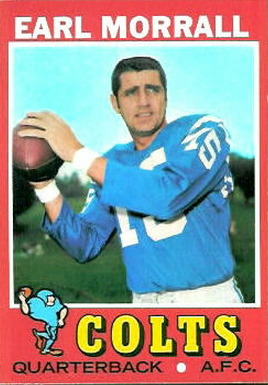 championship, winning the MVP award in the process. Alas, the feel-good story had a horrible ending: a 16-7 loss to the AFL’s Jets in the Super Bowl, due in large measure to three interceptions thrown by Morrall.
championship, winning the MVP award in the process. Alas, the feel-good story had a horrible ending: a 16-7 loss to the AFL’s Jets in the Super Bowl, due in large measure to three interceptions thrown by Morrall.
● Mike Livingston, 1969 Chiefs — Livingston didn’t exactly tear it up after Len Dawson was sidelined with a partially torn ACL, but he did win all six of his starts to help Kansas City get in the playoffs. By this time Dawson was operational again, and he quarterbacked the Chiefs to victories over the Jets and Raiders to win the AFL crown and the NFL’s Vikings to capture the Super Bowl.
● Earl Morrall, 1972 Dolphins — Ol’ Flattop was four years older, 38, when he did for the ’72 Dolphins what he’d done for the ’68 Colts. He didn’t just hold the fort until Bob Griese recovered from a fractured leg, he won 10 straight starts, including the playoff opener over the Browns. Then Griese came off the bench in the AFC title game against the Steelers, rallied Miami to a 21-17 victory and remained the QB in the Super Bowl, which the Dolphins also won to cap their perfect 17-0 season. But without Morrall, it might never have happened.
● Mike Kruczek, 1976 Steelers — Kruczek was the Eddie Danowski of ’76, a rookie quarterback who was suddenly thrust into a starting role because of injuries to Terry Bradshaw. He didn’t need to shoulder that much of the load because Pittsburgh’s defense was nigh impenetrable that year, pitching five shutouts, and running backs Franco Harris and Rocky Bleier both topped 1,000 yards. Still, he went 6-0 during Bradshaw’s absence, putting the Steelers in position for a record-tying third consecutive championship. They might have won it, too, if Harris (bruised ribs) and Bleier (sprained toe) hadn’t been sidelined for the AFC title game.
● Vince Ferragamo, 1979 Rams — A third-year QB, Ferragamo got his big chance when Pat Haden broke his finger in Week 10. He responded by winning six of seven starts, leaning heavily on a staunch defense, as the Rams advanced to their first Super Bowl. They even led the heavily favored Steelers in the fourth quarter, 19-17, but then Bradshaw and John Stallworth burst their bubble with this famous play:
● Jim Plunkett, 1980 Raiders — The 32-year-old former No. 1 overall pick had fallen completely off the radar until Dan Pastorini broke his leg in the fifth game. But with a better supporting cast than he had in New England, Plunkett became the quarterback he was always supposed to be, leading Oakland to the championship that year (and again in ’83). Say this for the guy: He was a finisher. In the AFC title game and Super Bowl, he posted passer ratings of 155.8 and 145
● Jeff Hostetler, 1990 Giants — Phil Simms’ late-season foot injury opened the door for Hostetler, who was pushing 30 and had spent nearly six years as an understudy. He made the most of the opportunity, playing steady, interception-free ball in the last five games, all victories, including memorable postseason stare downs of the 49ers (15-13) and Bills (20-19 in the Super Bowl). His mobility (200 rushing yards, two touchdowns) brought a new dimension to the Giants offense.
● Erik Kramer, 1991 Lions — Undrafted coming out of North Carolina State, this one-time CFLer took over for Rodney Peete (torn Achilles) halfway through the season and guided Detroit to seven wins in a row, the last a 38-6 horse-collaring of the Cowboys in the second round of the playoffs. On that one he completed 29 of 38 for 341 yards and three TDs, with no picks. The NFC championship game against the Redskins didn’t go quite as well, but it was still a heck of a run. (And of course, the Lions haven’t gotten that far since.)
● Kurt Warner, 1999 Rams — We might never see another season like Warner’s. He was like Bill Murray in Caddyshack (except he really did win the Masters — or the Super Bowl, at least).
It still seems incredible, all these years later. Warner, a product of the Arena League and NFL Europe, was slated to play behind Trent Green that season. But then the Chargers’ Rodney Harrison bent Green’s knee the wrong way in a preseason game, and Kurt proceeded to toss 41 touchdown passes, win both the NFL MVP and Super Bowl MVP awards and take his first steps toward Canton (I’m guessing).
● Tom Brady, 2001 Patriots — Brady, the 199th pick in the previous year’s draft, had hardly set foot on the field when Jets linebacker Mo Lewis knocked Drew Bledsoe out of the lineup in Week 2 with this crushing hit:
That was the last game Bledsoe started in New England. Brady took the job and ran with it, winning an improbable ring that year — thanks to a couple of last-second field goals by Adam Vinatieri — and two more in 2003 and ’04.
And now we have Stanton trying to add his name to the list. He doesn’t have the crunching ground game Kruczek had at his disposal, the offensive talent that glittered around Warner (and others) or a Hall of Fame coach running the show (as Livingston, Morrall, Kruczek, Hostetler and, almost certainly, Brady did). But as we’ve seen over the decades, from Danowski on down, there are more championship quarterbacks in the NFL than we think. All they need, some of them, is a break — of a leg, an ankle or some other part of their competition’s anatomy.
Here’s the kicker
In fact, here are two of them. The first is Stephen Gostkowski, who went over 100 points for the season in the Patriots’ ninth game. He’s only the second pure kicker in NFL/AFL history to get to 100 points — 101, actually — that fast. The other is Lawrence Tynes with the Giants two years ago (102).
But . . . three running backs and four multitaskers — guys who played an offensive position and doubled as kickers — also have accomplished the feat. Two of the seven did it twice. The details:
NFL/AFL PLAYERS WHO HAVE SCORED 100 POINTS IN THE FIRST NINE GAMES
| Year | Player, Team | TD | FG | PAT | Pts (Final Total*) |
|---|---|---|---|---|---|
| 2014 | K Stephen Gostkowski, Patriots | 0 | 34 | 29 | 101 (TBD) |
| 2012 | K Lawrence Tynes, Giants | 0 | 26 | 24 | 102 (145) |
| 2006 | RB LaDainian Tomlinson, Chargers | 18 | 0 | 0 | 108 (186*) |
| 2005 | RB Shaun Alexander, Seahawks | 17 | 0 | 0 | 102 (168*) |
| 1962 | WR-K Gino Cappelletti, Patriots (AFL) | 4 | 16 | 28 | 100 (128) |
| 1962 | RB-K Gene Mingo, Broncos (AFL) | 4 | 18 | 23 | 101 (137*) |
| 1961 | RB-K Paul Hornung, Packers | 10 | 12 | 34 | 130 (146*) |
| 1961 | WR-K Gino Cappelletti, Patriots (AFL) | 7 | 12 | 32 | 110 (147*) |
| 1960 | RB-K Paul Hornung, Packers | 11 | 11 | 30 | 129 (176*) |
| 1958 | RB Jim Brown, Browns | 17 | 0 | 0 | 102 (108*) |
| 1942 | WR-K Don Hutson, Packers | 15 | 0 | 29 | 119 (138*) |
*led league
Notes: Hornung reached 100 in just seven games in 1960 (100 exactly) and again in 1961 (101). Cappelletti had 100 through eight games in ’61, and Hutson had 104 through eight in ’42. . . . Hornung missed two games in ‘61 because of a military commitment.
Anyway, that’s a pretty impressive bunch. Hornung, Brown and Hutson are in the Hall of Fame, and Tomlinson figures to join them soon enough.
The second kicker I wanted to call to your attention is Shayne Graham, currently with the Saints. I say “currently” because Graham has certainly been making the rounds lately. Since he left the Bengals as a free agent in 2010, he’s been with 10 different teams and played at least one regular season game with five of them.
A brief summary of his travels:
● 2010 – Ravens (cut before season), Giants (1 game), Patriots (8).
● 2011 – Redskins (cut in camp), Cowboys (cut before season), Dolphins (2 games), Ravens (1).
● 2012 – Texans (16 games).
● 2013 – Browns (cut in camp), Steelers (on their roster for a game but wasn’t active), Saints (2).
● 2014 – Saints (9 games and counting).
How do ya like them frequent-flyer miles? But here’s the thing: Despite his job tenuousness, Graham has kicked the ball very well. In fact, in these five seasons — or parts thereof — he hasn’t missed a field goal try under 40 yards. The breakdown:
SHAYNE GRAHAM’S FIELD GOAL KICKING BY DISTANCE, 2010-14
| 0-19 | 20-29 | 30-39 | 40-49 | 50+ | Made | Missed | % |
|---|---|---|---|---|---|---|---|
| 2-2 | 22-22 | 22-22 | 18-14 | 10-5 | 65 | 9 | 87.2 |
(Numbers below distances are field goals attempted and made.)
To live out of a suitcase — well, practically — for five years and still perform at this level is . . . the definition of a pro. A guy like that deserves to kick in a dome at this stage of his career. He’s earned it.
Source: pro-football-reference.com
Fullback, first class
Not every militarized NFL player saw action in World War II. Some played football on various service teams and/or helped sell war bonds. Here’s one of a series of ads that ran in newspapers in 1943. Featured is Norm Standlee, the Bears’ Nagurski-esque fullback.
Too much, too fast?
The stories said Aaron Rodgers threw six touchdown passes in the first half Sunday night to tie the NFL/AFL record. Actually, it was better than that — or worse, depending on your point of view.
If you want to be exact about it, Rodgers threw for six scores in 20 minutes, 59 seconds in the Packers’ 55-14 blowout of the Bears. That’s quite a bit less than a half. It went like this:
1. 6:13 left, first quarter: 1-yard TD to TE Brandon Bostick.
2. 3:53, first quarter: 4-yard TD to TE Andrew Quarless.
3. 14:48, second quarter: 73-yard TD to WR Jordy Nelson.
4. 12:09, second quarter: 40-yard TD to Nelson.
5. 4:48, second quarter: 56-yard TD to RB Eddie Lacy.
6. 0:14, second quarter: 18-yard TD to WR Randall Cobb.
Consider: The record for a game is seven, and it’s been done only seven times. But Rodgers threw six in barely a third of a game. I know the Bears played atrocious defense, but is this a really good thing? Is it good that the rules are now so pro-passer that a QB can toss six touchdown passes in a tick less than 21 minutes?
After all, earlier in the day, Peyton Manning had thrown five in just 16:43 in the Broncos’ 41-17 scrimmage against the Raiders. His timeline looked like this:
1. 2:44 left, second quarter: 51-yard TD to RB C.J. Anderson.
2. 0:28, second quarter: 32-yard TD to WR Emmanuel Sanders.
3. 12:43, third quarter: 10-yard TD to TE Julius Thomas.
4. 6:52, third quarter: 32-yard TD to Thomas.
5. 1:01, third quarter: 15-yard TD to Sanders.
Granted, the Raiders, like the Bears, have one of the worst defenses in the league, but this is still a bit much. The game has gotten out of whack, if you ask me. And the way things are going, it’s only going to get out-of-whacker.
My favorite stat might be this: Together, Rodgers and Manning threw for 11 scores in 37:42. Now that’s what I’m looking forward to — the 11-TD game.
The only other quarterback to toss six touchdown passes in a half is the Raiders’ Daryle “The Mad Bomber” Lamonica in this battering of the Bills in 1969, the last year of the AFL. According to the Oakland Tribune, four of Lamonica’s TDs came in just six offensive plays during an eight-minute stretch of the second quarter.
“The [Buffalo] turnovers were coming so rapidly that [wide receiver] Warren Wells dashed onto the field without his helmet, so anxious was he to get in on the fun,” the Tribune said. “He was stopped by an official, more than Buffalo could do to him.”
Lamonica’s first half numbers: 24 attempts, 17 completions, 275 yards, 6 touchdowns. That’s awfully close to Rodgers’ 24-18-315-6 line.
The timeline of The Mad Bomber’s scoring tosses:
1. 12:53 left, first quarter: 53-yard TD to TE Billy Cannon.
2. 0:46, first quarter: 10-yard TD to RB Pete Banaszak.
3. 12:54, second quarter: 1-yard TD to Banaszak.
4. 12:17, second quarter: 13-yard TD to Wells.
5. 9:04, second quarter: 16-yard TD to WR Fred Biletnikoff.
6. 4:33, second quarter: 23-yard TD to Biletnikoff.
For those of you scoring at home, that’s six touchdown passes in 23:20 (to Rodgers’ 20:59).
But get this: Lamonica came close to throwing seven in the first half. The Tribune said he “fell six yards short of equaling the pro record of seven in a game when [wide receiver] Drew Buie was carried out of bounds short of the end zone on a 37-yard completion on the last play before the half.”
There was a funny sidelight to The Mad Bomber’s big day, by the way. The backstory: The year before, a crucial game between the Raiders and Jets had run long, and NBC made the infamous decision to cut away from it in the final minutes so it could begin airing the children’s movie Heidi on time. It was a public relations disaster for the network, even though it returned to the game before it was over (after being swamped with phone calls from irate fans).
Anyway, NBC had planned to follow the Raiders-Bills game with Heidi again, but there was no way it was going to make the same mistake twice. When the game spilled over into the next time slot — by eight minutes — the network stuck with it until the end. Only then was Heidi allowed to prance across the television screen.


